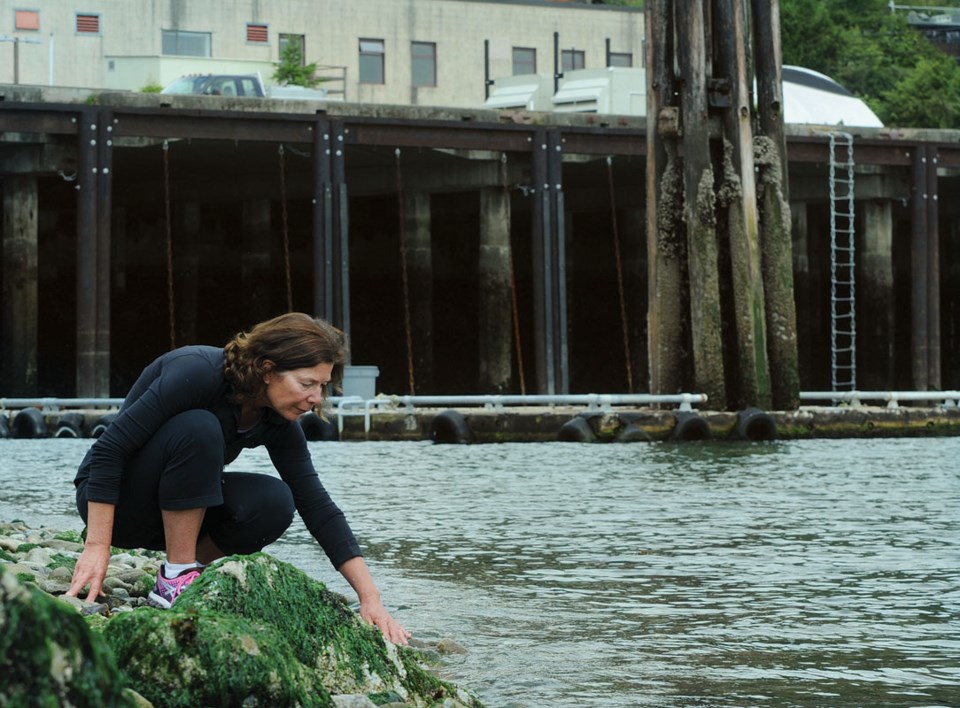A West Vancouver environmentalist is taking Fisheries and Oceans Canada to task for using toxic creosote on the department’s own docks.
The DFO Centre for Aquaculture and Environmental Research on Marine Drive was recently updated with new pilings coated in creosote, a tar-based preservative that is a known environmental hazard, according to Mary-Sue Atikinson.
“I was quite shocked and disgusted to be honest, considering that all of the problems regarding creosote are well known. To be actually installing that at this point in time is really bad,” she said. “They’re carcinogenic, mutagenic and toxic to both humans and aquatic organisms.”
Of particular concern are herring, which latch on to smooth surfaces like pier pilings while they spawn. The keystone species has been making a historic comeback in recent years, something that could be jeopardized by more creosote, Atkinson said.
Atikinson sought answers from Environment Canada, DFO and the Canadian Coast Guard, but only got the runaround, eventually learning that the federal government considers creosote acceptable and legal.
But Atkinson pointed out, she’s not the only one who would advise against creosote pilings. The European Union banned it for commercial use outright in 2003. The state of California opted to stop using it on all of its structures in 1993, while the state of Washington has banned it in fresh water and has put in place a creosote removal plan. And DFO itself, in the agency’s guidelines for dock and boathouse construction in freshwater systems, states: “Creosote treated wood should not be used in or near water.”
A 2015 UBC literature review done at the request of the Vancouver Fraser Port Authority concluded creosote should be phased out and environmentally friendlier alternatives should be used, wherever possible. The higher upfront costs could be cheaper over the long-run, the study suggested.
At the very least, DFO should wrap the pilings in plastic, a method that’s been known to mitigate the impact on herring in Squamish, False Creek, and the Cowichan River, Atkinson said.
A video shot and posted online by Squamish environmentalist John Buchanan depicts pilings that have been wrapped in plastic absolutely coated in herring spawn. When the camera lowers to the point of the piling without plastic, the piling is devoid of life.
“It’s really exciting to see. You can do something like that and cause such a good result. I think it’s really important to leave all those options open in case herring want to spawn there in the future,” Atkinson said.
In response to an interview request, DFO provided an emailed statement saying the use of creosote in this instance was acceptable.
“DFO has undertaken studies on the use of treated timber in the marine environment, which indicate that it continues to have a place in certain harbour structures, along with alternative materials such as steel and concrete,” it read. “Based on these studies, DFO has implemented guidelines on the use of treated timber in the marine environment, and the use of creosote-treated piles is in full compliance with all current regulatory requirements regarding the use of wood preservatives in a marine environment.”
The project’s design and construction was also evaluated by outside consultants, the statement noted.
That’s not good enough, Atkinson said. “My main issue is that I think that DFO should be leaders in best practices and stewardship of the aquatic environment. … I think that when and if they do upgrades, they should not use creosote in the future,” she said. “That should be a policy within all of the federal government, considering the negative impact on the aquatic ecosystem.”



